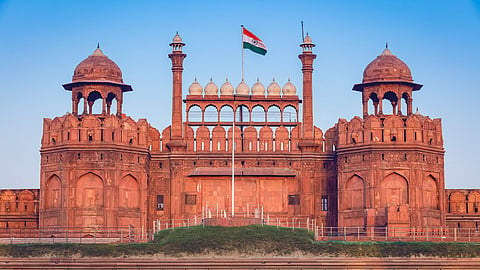

(Managing Director, Rubfila International Ltd & Premier Tissues India Ltd)
Just a few months ago, when the Trump administration returned to power, many believed India would be the first to sign a new trade deal with Washington. Instead, we find ourselves in an unenviable position: India is now only the second country, after Brazil, to face the steepest tariff wall of 50 percent.
The collapse of talks has been traced largely to India’s reluctance to grant unrestricted access for US agricultural and dairy products, including genetically modified (GM) crops—issues politically sensitive in India, but crucial to American negotiators. Predictably, the debate at home has revolved around trade balances, export losses, job cuts and slower growth. Yet the deeper issue is not merely market access, but the structural challenges of India’s economy and the way it approaches trade, industry and self-reliance.
Unlike Germany or Vietnam, which rely heavily on exports, India is less exposed—exports make up just about 21 percent of GDP. That provides some cushion, but also signals untapped potential. The US, with its 340 million consumers, is certainly an attractive market. But India itself, with a population of 1.4 billion—larger than the US and Europe combined—offers immense domestic opportunities. Much of this population remains under-served, whether in products, services, logistics or digital consumption.
If Indian companies focused more intently on this vast home market, the country could build an industrial base strong enough to grow on its own momentum, rather than being hostage to the vagaries of American trade policy. The tariff shock is painful, but it may also be the best chance to turn inward and strengthen industry for India’s own people.
In hindsight, India might have shown more flexibility on agriculture during negotiations. Successive governments have invoked the rhetoric of “protecting farmers” whenever imports of agricultural products or GM crops are raised. Yet, one must ask whether Indian farmers are really better off under the current restrictions. The answer is debatable. Policy debates, such as the NITI Aayog’s briefly floated suggestion to allow GM imports, reflect a recognition of the need for modernisation. It is politics, not economics, that has stalled progress.
Meanwhile, the immediate impact of the tariff will be felt most sharply in labour-intensive sectors like textiles, gems and jewellery, and seafood—industries that employ millions. Political narratives focus on farmers, but the plight of factory workers, logistics staff and informal labourers who stand to lose jobs is no less pressing.
Much of the anxiety about opening India’s dairy market to US products appears overstated. Indian consumers prefer fresh, low-cost milk produced locally, and the fragmented, cooperative-led structure of the sector makes mass penetration by US suppliers highly unlikely. Infrastructure gaps in cold storage and transport further limit the prospects. Imported dairy may capture niche segments, but wholesale displacement of Indian producers is improbable.
A harder truth is that India remains a difficult and expensive place to do business. Regulatory delays, high compliance burdens and costly logistics all erode competitiveness. The Prime Minister has spoken of deploying an “arsenal of reforms” to counter the tariff shock. These must now translate into action, particularly in cutting the cost of doing business. Complaining about tariffs is no solution; the real answer lies in enabling Indian companies to thrive even in hostile global conditions.
India and China began their journeys of liberalisation around the same time. China is now the “factory of the world”, not by accident, but because its government actively supported industries to scale up, dominate supply chains and create global capacity. India, in contrast, has continued to view industry largely as a profit-seeking private activity, rather than a pillar of national strength. Whenever government does step in with support, it is often criticised as favouring private business, instead of being recognised as nation-building.
Former NITI Aayog CEO Amitabh Kant has suggested tourism as a way to earn foreign exchange and offset losses from exports. India’s cultural heritage and diversity give it great potential, but poor infrastructure—potholed roads, unhygienic conditions, safety concerns, expensive hotels and inadequate transport—limit the sector’s appeal. Competing destinations such as Thailand, the UAE and Vietnam are far better positioned. Unless India invests heavily in both soft and hard infrastructure, tourism will remain an under-utilised opportunity.
Efforts to rationalise GST rates are welcome. The complex multi-tier structure created for revenue purposes has burdened businesses. Lowering GST rates—perhaps to 5 percent—could energise the economy, but there is a risk companies might simply pocket the gains. Strong anti-profiteering mechanisms must therefore ensure benefits are passed on to consumers.
India must accelerate diversification beyond the US and a few large markets. Dependence on limited destinations makes the country vulnerable to tariffs and geopolitical shocks. Stronger ties with ASEAN, Africa, Latin America, the Middle East and Europe would spread risk and increase resilience.
The RBI has indicated readiness to step in to support affected sectors. But this must go beyond symbolic measures. Interest subsidies, loan moratoriums and favourable credit terms are needed, at least temporarily, to cushion the blow. The government, too, should offer targeted export incentives and financial assistance to help companies explore new markets until conditions stabilise.
Calls for retaliatory tariffs are counterproductive. Instead, India should treat this moment as a wake-up call. Reducing dependence on a few markets, cutting the cost of doing business, and treating industry as a strategic asset will help India withstand external shocks and move towards becoming a true global economic power.
At the same time, diplomacy must not be neglected. A strong relationship with the US carries strategic benefits that India should not lightly forfeit. Tariffs should not mark a breakdown, but a difficult phase in a broader partnership.
The US tariff hike is not a death blow. It is a test—and an opportunity. If India responds with structural reform, resilience and foresight, our goods may yet return to American shelves under fairer terms. As the saying goes, a crisis is too good an opportunity to waste.